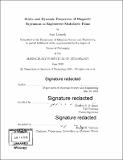| dc.contributor.advisor | Geoffrey S. D. Beach. | en_US |
| dc.contributor.author | Lemesh, Ivan. | en_US |
| dc.contributor.other | Massachusetts Institute of Technology. Department of Materials Science and Engineering. | en_US |
| dc.date.accessioned | 2019-09-16T22:34:42Z | |
| dc.date.available | 2019-09-16T22:34:42Z | |
| dc.date.copyright | 2019 | en_US |
| dc.date.issued | 2019 | en_US |
| dc.identifier.uri | https://hdl.handle.net/1721.1/122179 | |
| dc.description | Thesis: Ph. D., Massachusetts Institute of Technology, Department of Materials Science and Engineering, 2019 | en_US |
| dc.description | Cataloged from PDF version of thesis. | en_US |
| dc.description | Includes bibliographical references (pages 205-219). | en_US |
| dc.description.abstract | Magnetic textures known as skyrmions promise new breakthroughs in memory, logic, and neuromorphic applications. Skyrmions have been found in a variety of material systems, yet there existed no experimental evidence of a material that could simultaneously host them at room temperature and also allow for their reproducible current-induced nucleation and motion. One main goal of this thesis is to fill this gap and demonstrate all the aforementioned properties in the introduced here [Pt/CoFeB/MgO]₁₅ thin film heterostructures, consisting of a perpendicularly magnetized ferromagnetic layer (M), a heavy metal (H), and a symmetry-breaking spacer layer (S). Here, I developed, fabricated, and characterized the [Pt/CoFeB/MgO]₁₅ multilayers with an extremely low density of pinning centers, which enable not only a fully reproducible skyrmion motion but also a clean study of the skyrmion nucleation process. By using X-ray microscopy, I performed the imaging of various magnetic textures in these multilayers and studied their current-induced generation and motion as a function of applied field and temperature. Finally, another goal of this work is to establish a direct link between the properties of these [H/M/S][subscript N]-type materials and the structure of magnetic textures that they can host. The energetics of such systems is understood very poorly due to the very complex multilayer stray fields and up until now, most of their analysis involved the exclusive use of micromagnetic simulations. Here, I develop an alternative theoretical approach by calculating all the stray field interactions analytically, which enables the prediction of the exact structure and dynamics of magnetic domain walls, domains, and skyrmions. Thesis | en_US |
| dc.description.sponsorship | "Support of the U.S. Department of Energy (DOE), Office of Science, Basic Energy Sciences (BES) under Award No. DE-SC0012371, and of the DARPA TEE program"--page 7. | en_US |
| dc.description.statementofresponsibility | by Ivan Lemesh. | en_US |
| dc.format.extent | 219 pages | en_US |
| dc.language.iso | eng | en_US |
| dc.publisher | Massachusetts Institute of Technology | en_US |
| dc.rights | MIT theses are protected by copyright. They may be viewed, downloaded, or printed from this source but further reproduction or distribution in any format is prohibited without written permission. | en_US |
| dc.rights.uri | http://dspace.mit.edu/handle/1721.1/7582 | en_US |
| dc.subject | Materials Science and Engineering. | en_US |
| dc.title | Static and dynamic properties of magnetic Skyrmions in engineered multilayer films | en_US |
| dc.type | Thesis | en_US |
| dc.description.degree | Ph. D. | en_US |
| dc.contributor.department | Massachusetts Institute of Technology. Department of Materials Science and Engineering | en_US |
| dc.identifier.oclc | 1117775480 | en_US |
| dc.description.collection | Ph.D. Massachusetts Institute of Technology, Department of Materials Science and Engineering | en_US |
| dspace.imported | 2019-09-16T22:34:40Z | en_US |
| mit.thesis.degree | Doctoral | en_US |
| mit.thesis.department | MatSci | en_US |
